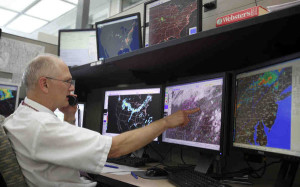 Have you ever heard the weatherman mention the National Storm Prediction Center and wondered what it was? You might be surprised to learn it is actually a government agency, and that they do more than predict storms.
Have you ever heard the weatherman mention the National Storm Prediction Center and wondered what it was? You might be surprised to learn it is actually a government agency, and that they do more than predict storms.
Storm Prediction
The National Storm Prediction Center operates under the control of the National Weather Service(NWS). Their main task is to forecast and assess the risk of severe thunderstorms and tornadoes throughout the United States in the contiguous 48 states. They also predict hazardous winter weather and help to determine fire hazards associated with the weather. The following categories are used when assessing the risk of a storm for a particular day:
- Marginal risk
- Slight risk
- Enhanced risk
- Moderate risk
- High risk
Brief History
The National Storm Prediction Center was established in 1952 in Washington D.C. as the Severe Local Storms Unit (SELS). It was made up of a special group of forecasters in the U.S. Weather Bureau. In 1954 the unit moved to Kansas City, Missouri. Eventually the unit evolved into the National Severe Storms Forecast Center (NSSFC). Through the years, the center issued status reports on weather watches and began using computerized data in 1971 to do so. In 1995 the center moved to their current location in Norman, Oklahoma where they simply became known as the National Storm Prediction Center.
Other Services
Even though they are called a storm prediction center, which is their main focus, the agency offers many other types of weather-related services. Besides predicting storms and bad weather, they are also concerned about public safety in all types of weather and outdoor activities where weather is often a factor. Some of their safety concerns include:
- Air quality
- Rip currents
- Safe boating
- Ultra Violet (UV) Radiation
- Wildland Fire Safety
- Heat
- Floods, Hurricanes and Tsuanmis
Data for the weather safety concerns in the above areas are usually gathered and issued with the help of other national agencies. For instance, when it comes to air quality, the storm prediction center works with the Environmental Protection Agency (EPA). Together, these two agencies work together to give the appropriate forecast in order to limit the harmful effects of poor air quality.
Weather Statistics
The Storm Prediction Center helps alert the public to weather-related statistics. These statistics include fatalities from floods, lightning, tornadoes, hurricanes, the heat, the cold, wind and rip currents in the 50 states, Guam, the Virgin Islands, and Puerto Rico. Statistics in most of these categories have been compiled by the Office of Services and the National Climatic Data Center since 1940.
Related Resource: National Hurricane Center
As you can see, this center has a huge responsibility in keeping the public safe in many weather-related capacities. The next you hear about the National Storm Prediction Center, you’ll realize it is a government agency that does so much more than predict storms.